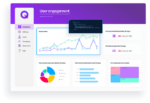Analytics is the accepted way to determine what business decisions are right for your organization, but now it is up to business teams and analytics teams to determine what types of solutions will best help them make these decisions, according to the second keynote at the Predictive Analytics conference, given by Thomas Davenport, a professor at Babson College and research director at the International Institute for Analytics.
The keynote was offered as a joint session to those attending the three concurrent conferences under the Data Driven Business Week umbrella, which also included eMetrics and Text Analytics World. Davenport said he enjoyed speaking to all three groups because he, as an analytics professional, looks at their adoption as a larger effort, comprised of professionals from all three conferences.
Davenport told conference attendees to embrace analytics, which he assumed most already had, given that they were attending the conference devoted to analytics. So instead of continuing to preach a respect for analytics, he changed the focus to taking these extraordinary results and making them everyday occurrences.
Davenport’s “Everyday Analytics” presentation discussed several successes in the industry and how to make them more commonplace. Predictable results in analytics require that team members create a set of solutions they are good at delivering reliable results with, he said.
It is by creating this list of solutions that teams can then begin to industrialize their process. Industrialized analytics are embedded, scalable and deliver consistent results.
“We can’t do it all. We have to help decision makers produce better decisions,” Davenport said, adding that analytics for the masses really hasn’t taken off and that it is up to analytics professionals to make gathering analytics easier, depending on their own industry and needs.
Process thinking (where developers associate a step-by-step process with how they go about their work on a daily basis to deliver results) is necessary in order to standardize the process of reading and delivering analytics, Davenport said. “Analytical solutions should be scalable, reliable, quick and well marketed,” he said.
Analytics are understood by the analytics industry at large, but since they are vitally important to making informed business decisions, Davenport said analysts (or “math people”) need to make it very easy for businesspeople to understand.
It is not a two-way street, he said. The math people need to know a lot about the business and to understand what they need to deliver, while the businesspeople only need to understand their customized solution.
Solutions should be customized as mobile apps are, Davenport said, with a specific app delivering specific portions of the overall analytics picture. In order to do this, software teams really need to understand what their business teams need and then understand how the businesspeople will be using these solutions.
He said that analysts really need to make clients on the business team aware of what they do well, and how those results can be delivered to help business teams understand how the results can help their overall processes and goals.
Analytics teams should be passionate about one set of approaches that they do well in order to consistently deliver reliable reports, he said. This will also help business teams understand the goals of analytics.
As far as tools go, Davenport said the solutions should be customized for business users, and multiple tools should be offered to analysts. This goes against the old ways of thinking about business intelligence tools because, as he said, analysts originally thought business team members should have the option to view all solutions and the responsibility to parse through the data.
Davenport said that because of the amount of data today, this is no longer the best option.




